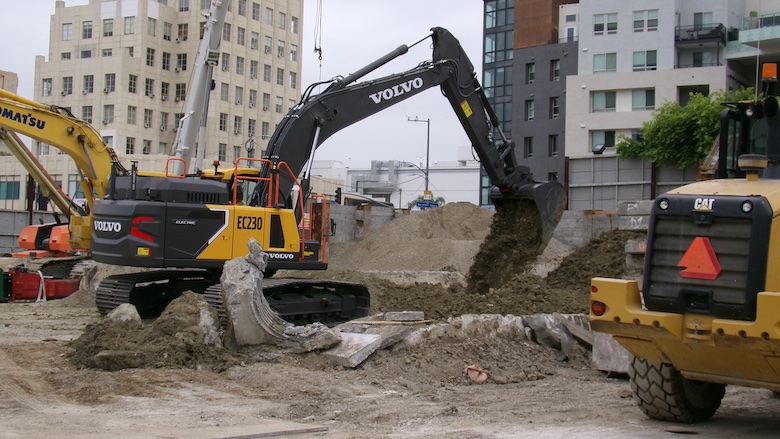Group Aims to Boost Adoption of Electric Construction Equipment in the US


An all-electric Volvo CE EC230 excavator was used on a Los Angeles subway project.
Photo courtesy of Skanska
Growth in use of electric equipment in construction has been relatively slow in the U.S. despite successful pilot efforts, but a new coalition of cities, municipal agencies and industry groups is looking to promote wider adoption.
The New York City Mayor’s Office of Climate and Environmental Justice joined with C40 Cities Sept. 20 to announce the launch of the North American Electric Construction Coalition, “which unites cities and industry partners that are committed to developing the electric construction equipment market in North America,” a statement from the mayor’s office said. “Making the switch to this type of equipment helps to reduce noise and air pollution, greenhouse gas emissions and achieve carbon neutrality.”
The statement also noted that New York City has sought in recent years to strengthen its commitments to reducing embodied carbon and promote cleaner construction practices. “The city sees electrifying construction sites as integral to our environmental justice and decarbonization agenda,” the release states.
Also joining the coalition are Austin, San Diego and Montreal, as well as Boulder County, Colo. Industry partners include American Institute of Architects New York chapter, the Building Trades Employers Association and the Carbon Leadership Forum. Rolling admission will allow additional members to continue to join through the fall and winter. “The construction industry accounts for 23% of global greenhouse gas emissions,” according to C40 Cities, a global network of mayors.
“The decision by governments across North America to not only promote electric-powered construction equipment, but also to leverage their capital budgets to support utilization, has great potential to increase the availability of such equipment,” says Building Trades Employers Association President and CEO Elizabeth Crowley.
“Major cities like New York and the surrounding New Jersey area are already making electric construction vehicles more available in the marketplace, ensuring they meet safety and durability requirements. Necessary machines on all jobsites, such as electric-powered backhoes and forklifts, are seeing use in New York, offering the quality and dependability of their fuel counterparts.”
While uptake overall has been slow, there have been some successful pilots for electric equipment on large urban projects in the U.S. Earlier this year, Skanska completed two pilots of all-electric heavy equipment on the Los Angeles D Line Subway Extension project. It deployed a Volvo CE 23-ton EC230 electric excavator in February to load trucks with debris from an underground tunnel.
Using an electric excavator instead of a conventional, diesel-powered one helped reduce hourly carbon emissions by 66% and hourly costs by 74% during the 90-day pilot, Skanska announced. The goal was to “test capability of a battery-powered excavator to perform the necessary construction work, particularly in relation to its diesel-powered counterpart,” it said.
The pilot was in support of Skanska’s global goal of reducing its jobsites’ embodied carbon emissions. Likewise, it helps supports Volvo’s goal of attaining net-zero emissions in its value chain by 2040 and net-zero emissions for its entire rolling fleet by 2050. Skanska also ran a pilot on the same project for a HAMM HD 12eVV electric tandem roller, one of only five pre-production models of its type found in North America.
While there are successful pilots, many U.S. contractors are more drawn to hybrids and other intermediate steps rather than embracing fully electric machines. Michael Battaglia, president of the Association of Equipment Management Professionals, which represents companies with a combined fleet value of about $23.6 billion, says members are “focused on hybrid technology that is easy to adopt, maintain and manage with a clear return on investment.”
Battaglia acknowledges that electric equipment is one of many approaches to help with carbon reduction for an equipment fleet, and says his group is educating end users about available options. He adds that development of mobile fast-charging stations will be critical to long-term adoption by industry.
Johanna Knapschaefer, ENR’s New England Special Correspondent, has been writing about trends in design and construction of buildings, bridges, tunnels and other infrastructure for more than a decade. She also profiles award-winning industry leaders and delves into broader construction issues such as workforce training, worker safety and health, climate change remediation and emerging offshore wind and tidal energy developments. Over the past two decades, her articles have appeared in Architectural Record, BusinessWeek, the Boston Globe, American Banker, Modern Metals, BusinessNH Magazine, Pittsburgh Magazine and many other publications. Johanna is fluent in Japanese, and taught English and academic writing in the Science and Engineering Department of Ritsumeikan University, Kyoto, while living in Japan for eight years.
When not writing, Johanna enjoys mountain climbing, singing and playing her Spanish guitar.




